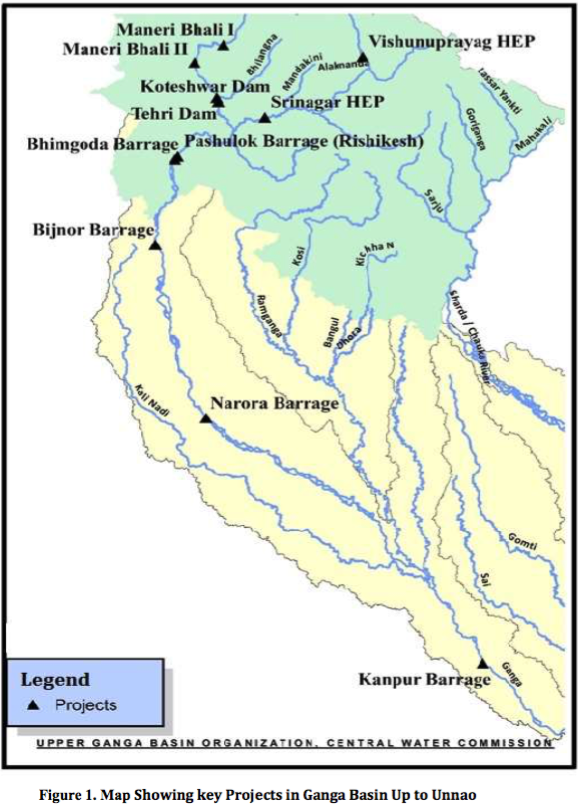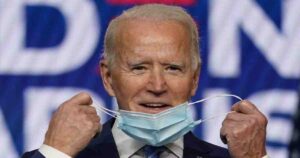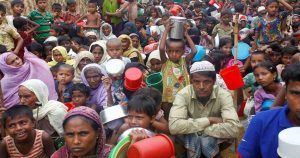March 19, 2020 SANDRP
A review of the Indian Central Water Commission (CWC) monitoring reports of all four quarters of 2019 reveals that all the eleven projects that were being monitored in Ganga basin have violated the mandatory Environment flows notification in each of the four quarters of 2019 at some time or the other. The reports are of poor quality with CWC forgetting which states are in the Ganga basin and even the relative location of the projects. The CWC also seems to have no clue as to what constitutes Environment flows. No punitive action is initiated in any of the cases of violations even after the flows notification implementation becomes legally mandatory from December 15, 2019, as per the NMCG notification of Sept 14, 2019. On Oct 9, 2018, the National Mission on Clean Ganga (NMCG) under Union Ministry of Water Resources, River Development and Ganga Rejuvenation (MoWR for short) came out with a notification on mandatory Environment flows in Ganga. The Notification itself had limited itself to a small part of the Ganga basin and that too had many serious problems as we see below. The notification was brought out with much fanfare by the then Union Minister of Water Resources Shri Nitin Gadkari.
A PIB (Press Information Bureau of Government of India) press release of Oct 10, 2018[ii] said: “Calling this a significant development, Union Minister for Water Resources, River Development and Ganga Rejuvenation Shri Nitin Gadkari said that the notification of e-flow for the river would go a long way in ensuring its Aviralta or continuous flow… “This is a very significant moment. The discussions on notifying e flow of Ganga have been going on for a long time. We have taken this step to ensure a minimum amount of flow in the river”, Shri Gadkari said… Union Minister for Drinking Water and Sanitation Sushri Uma Bharti called the notification of e-flow for Ganga a “historic” step and thanked Shri Gadkari for taking forward the work she had started.”
The Central Water Commission (CWC) was responsible under the notification for “supervision, Monitoring, regulation of flows and reporting necessary information to reporting authority” and was mandated to “submit flow monitoring-cum-compliance report on a quarterly basis” to NMCG. The choice of CWC for this monitoring and the regulatory task is problematic because CWC is a subordinate organisation of MoWR, monitoring and compliance agency should have been an independent agency. Moreover, CWC has a very poor track record in terms of valuing environment flows or rivers.
As Bhopal Singh, Chief Engineer of Upper Ganga Basin Organisation of CWC said at India Water Week Program in Sept 2019[iii] and also underlines in National Water Policy 2012, “Flow discharges of a certain magnitude, timing, frequency and duration are needed to sustain holistic flow regime for river dependent ecosystems primarily to ensure the health of the aquatic life in rivers and also to sustain various goods and services being otherwise provided by the rivers”.
Unscientific, non-transparent & ecologically blind E flow notification The key problems with the Environment flow norms mandated by NMCG through the Oct 9, 2018 notification are listed here.
• Excludes most of Ganga Basin The Notification is about Ganga basin, but it excludes most of the Ganga basin, including all the tributaries, and the area downstream of Unnao. Even within this area, the notification excludes all small mini and micro-hydro projects, assuming, without any scientific basis, that these projects “do not alter the flow characteristics of the river or stream significantly”. Each of these projects break the upstream-downstream longitudinal connectivity of the river/ stream where they are located.
• Non-Transparent The e-flow notification does not say who decided the quantum of e-flows mentioned and how. Without this, the e-flows seem to have been arbitrarily decided.
• Unscientific The notification did not provide any science or scientific process in defining environment flows as mandated for different locations and seasons. There is no scientific consistency in the environment flows at different locations as given in the notification.
• Inconsistent There is not even internal consistency in the e-flow norms given in the notification. So for example, while three-season flows are mandated for hydropower projects, two-season flows are mandated for the four barrages on the Ganga. Moreover, the flows mandated for Bijnor, Narora and Kanpur barrages, all progressively downstream and hence located where river catchments and hence flows increase, are same for all three locations and in fact LOWER than the flow mandated at upstream Bhimgoda barrage.
• Ecologically blind The Ganga, like all rivers, does not carry just water. The river flows also include the flow of silt, nutrients and biota, the last one both upstream and downstream. But the e-flow notification does not even mention this reality and need to ensure the river flow to ensure the flow of silt, nutrients and biota. Moreover, it is not just the quantum of water releases that is important, but also the manner of release, to ensure that it helps the river to longitudinally connect upstream and downstream from the project, but the e-flow notification does not mention that at all. This can lead us to the absurd situation of project authorities claiming, as they actually do (as we see below) that water flowing through the turbines of hydropower project should be considered e-flows.
CWC Quarterly reports CWC has been coming out with quarterly reports as required under the notification since the January-March 2019 quarter (Q1). So by now we have reports of four quarters of 2019: Q1[iv], Q2 (Apr-June 2019), Q3 (July-Sept 2019) and Q4 (Oct-Dec 2019). A review of these four quarterly reports reveal, as elaborated below, all eleven projects are violating the notification in one way or another. But the CWC reports also show how shoddy has been the work of India’s premier technical body on water resources, in existence since 1945. Listed here are just two illustrations.
• Each of the four quarterly report mention: “The drainage area of of the basin lies in 9 states…” forgetting that huge parts of Jharkhand and Chhattisgarh also lie in Ganga basin, thus a total of eleven states are part of Ganga basin, not 9.
• Figure 1 (a map of the basin) in each of the four reports show Koteshwar project UPSTREAM of Tehri Dam, opposite of what is the situation.
The CWC reports were also inconsistent, the executive summary not reflecting what is stated in the full report. It also did not find it problematic that Tehri and Koteshwar projects were releasing mandatory flows through turbines. CWC reports also did not state that Tehri project while giving daily average flows, was, in fact, hiding the fact that it was not abiding by the hourly flow releases since the project was operating as a peaking station in most months. Thus in such months, the daily average was meaningless for hourly flow releases.
A review of the four quarterly reports to assess the compliance of the eleven projects with the even these minimalist, diluted and problematic e-flows notification reveals shocking reality.
On Automatic flow data acquisition and transmission facilities, The e-flow notification said: “the concerned project developers or authorities shall install automatic data acquisition and data transmission facilities or required necessary infrastructure at project sites at appropriate locations specified by the Central Water Commission within six months from the date of this order”. Even by December 2019, 15 months after the date of the order, none of the eleven projects had ensured this happens. Some projects like the THDC’s Tehri and Koteshwar already have this but are not providing CWC with the data from these facilities, so having such facilities become meaningless for implementation of the e-flows notification. No punitive action has been taken against any of the projects for this violation by NMCG.
On providing Hourly flow data The e-flow notification required that for each of the project “flow conditions in these river reaches shall be monitored at hourly intervals”. The CWC report provides the project-wise compliance situation in this regard in its reports for quarter 2, 3 and 4, each for 4, 14 and 7 days respectively. Even from this limited feedback, we can see that none of the eleven projects shows full compliance even in terms of providing hourly data as required.
• The fourth-quarter report provides the status of hourly data provision for the week 23-29, 2019, when the notification had become legally mandatory (since Dec 15, 2019). Even in this mandatory period, only two projects provided the hourly data in a timely fashion for all seven reporting days: Maneri Bhali-1 (MB-1) and Vishnuprayag. However, MB-1 and Vishnuprayag projects violated the norm in 6 and 3 of the 14 reporting days in Q3 (in two of these days, NO DATA was provided by the two projects) respectively. Both projects also violated this norm in Q2 too.
• Tehri project was the worst violator in this respect as it did not provide hourly releases for any of the reporting days. It only provided daily average flows, a misleading figure for environmental flows for all the reporting days in all quarters, in spite of repeated warnings. As CWC has reported, Tehri has the recorders to provide hourly flows, but THDC intentionally did not provide these figures on any of the days throughout the year and instead provided daily figures. CWC should have recorded this intentional violation by THDC to mislead, but CWC did not.
• Kanpur barrage is another project that has not provided hourly flow data throughout the year, on all reporting dates in Q2, Q3 and Q4. In Q1 and Q2, in fact, it did not provide ANY data, going by CWC reports. In Q3 and Q4, it provided two-hourly data, even in the legally mandatory period.
• Bijnor barrage also did not provide any flow data in Q4 in six of the seven reporting days. Pashulok and Narora barrages did not provide hourly flow data in Q4 in one of the seven reporting days.
On e-flow releases complying with notification, The NMCG notification had 3 season (monsoon (June-Sept), lean season (Oct, Apr, May) and dry (Nov-March) season) norms for the seven hydropower projects and two season (monsoon (June-Sept) and non-monsoon (Oct-May)) norms for the four barrages.
• CWC has reported in Q4 that minimum mandated flows were not being followed by a large number of days in each quarter for MB-1, MB-2, Vishnuprayag, Srinagar and Pashulok barrage. The worst performers in this respect were MB-2 and Srinagar HEPs. Pashulok barrage, Vishnuprayag and MB-1 were only slightly better, in that order.
• Which seems to suggest that Tehri & Koteshwar are the only hydro projects among the monitored projects that did not violate the norms. But this is not correct. Tehri has NEVER reported hourly flow data. If even the data is not provided, one cannot even know if the e-flow is as per the notification. The report of the expert team’s visit to the project during 7-9 Aug 2019, annexed with the Q3 report says about Tehri project: “The project is being used for generating power during peak demand and as such is not running continuously. Accordingly, the project is though meeting the e-flow requirement as far as the flow volume on a daily basis is concerned, but not on an hourly basis as water is not released continuously throughout the day.” This exposes the sham claim, indirectly supported by CWC report that the Tehri project meets the e-flow notification releases. It is clear that Tehri project not only violates the e-flow norms, it, in fact, does not even intend to follow it and actually hides the violation by providing daily flow data when it has the instruments for monitoring hourly data. CWC, but not listing Tehri project as a violator of the e-flow releases, has indirectly not only mislead NMCG and everyone else but also shown its bias, once again showing why CWC is not the right body for ensuring monitoring or compliance of the e-flow norms.
How ecological blind CWC is, gets further exposed when we read the expert team visit report mentioned above for Koteshwar project: “The flows including mandated e-flows are being released through the penstock. At least one machine is running continuously with a minimum discharge of 150 cumecs. Thus, the project is meeting E-flow norms continuously.” How can the water flowing through the penstock (which basically means, flowing through turbines) be considered meeting e-flow norms? The Koteshwar project, this means, has NEVER met the e-flow norms.
• Thus all the seven hydropower projects have violated the e-flow release requirements in Q4. The situation is more or less the same in the other three quarters too with slight variations.
• Among the four barrages, since Kanpur barrage has never provided hourly flow release data, there is no way to ascertain if it released the required hourly flows. Similarly, the Bijnor barrage had not submitted the hourly flow data in six of the seven reporting days, so there is no way to ascertain its compliance. This is also true for Narora barrage at least during one of the seven reporting days in Q4. This means that we do not have data to conclude compliance at least in case of three of the four barrages, Bhimgoda barrage being the only exception.
CWC should have also put in place a system of validation of the data provided by the projects and mentioned in its quarterly report if the claims of the projects is validated by its independent observations. But CWC reports do not provide such validation.
THDC the worst performer? There are two projects of THDC among the 11 projects being covered by the NMCG notification: 1000 MW Tehri and 400 MW Koteshwar. In every aspect, be it providing automated data (in spite of having an automatic monitoring system in place), in providing hourly data or adhering to environment flows mandated by the notification, THDC projects are the worst performers, going by the CWC reports. In fact, THDC has gone a step further and provided misleading figures and also patently wrong claims about flow data and e-flows. Unfortunately, CWC reports do not bring this reality out.

What about Demand Side measures? The NMCG e-flows notification had an additional requirement. It said: “The concerned Central and State authorities shall implement demand-side management plans to reduce water withdrawal from River Ganga by adopting good and scientific practices such as an efficient method of irrigation, reuse and recycle of water including monitoring and regulation of groundwater withdrawals for various purposes.” This is a very important part of the e-flows notification, but the CWC reports provide no information about compliance with this requirement by any of the Central or State authorities.
The way forward This review shows that while the e-flow notification of NMCG is seriously flowed, even those minimalist norms are not being followed by almost any of the eleven projects being monitored, going by CWC’s four quarterly Status reports for 2019. And so far no action has been taken against the violators. The e-flow notification itself needs to change, considering its serious flaws if NMCG’s objective of rejuvenation of Ganga is to be achieved. The reports and the review further prove that CWC is not the right body for achieving and compliance with the environmental flows, we need an independent body that has a better track record and no conflict of interest. And if there are no implications of violations, how does the NMCG hope to achieve compliance?
SANDRP (ht.sandrp@gmail.com)
Source: https://sandrp.in/2020/03/19/implementation-of-nmcgs-ganga-river-e-flows-in-2019-all-projects-violating-minimalist-norms/




